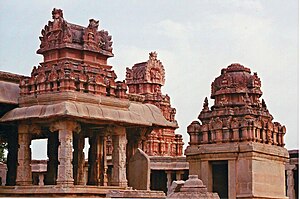Vijayanagara literature
This article needs additional citations for verification. (January 2024) |

Vijayanagara literature was produced in the
Kannada

Kannada literature took a strong Hindu bent with the patronage of the Vijayanagara kings.[1][2][3][4] Some eminent names were Kumara Vyasa, Narahari, BhimaKavi, Padmanaka, Mallanarya, Singiraja and Chamarasa.
Jain poets
Among
Shaiva poets
Veerashaiva literature saw a renaissance during this period. Singiraja wrote Singirajapurana and Malabasavaraja Charitra, Mallanarya of Gubbi who was patronised by Krishnadevaraya wrote Veerasaivamrita Purana (1530), Bhavachintaratna (1513) and Satyendra Cholakathe. Deva Raya II patronised several Virashaivas like Lakkana Dandesa who wrote Shivatatwa Chintamani, Chamarasa who wrote Prabhulinga Leele, Jakkanarya wrote Nurondushthala. Guru Basava wrote seven works, six in Shatpadi metre called Saptakavya including the Shivayoganga Bhushana and the Avadhutagite. Shivagna Prasadi Mahadevayya and Halageyadeva were famous for their Shunya Sampadane.
Among
Secular literature
King Deva Raya II was a poet and authored, in Kannada, the Sobagina Sone, a collection of romantic stories in the form of a narration by the author to his wife.[5] Manjaraja I a Jain authored a book on toxicology called Khagendramanidarpana, Abhinava Chandra wrote on veterinary sciences in Asva-vaidya, Sridharadeva wrote a medical work called Vaidyamrita, Deparaja a Virashiava wrote a collection of romances called Sobagina-sone, Brahmin poet Manjaraja II wrote Manjaraja-Nighantu (1398) was a metrical lexicon giving Kannada meanings of Sanskrit words, Lingamantri authored the lexicon Kabbigarakaipidi, Viarkta Tontadarya wrote the lexicon Karnatakasabdamanjari, Devottama a Jain wrote a lexicon Nanartharatnakara.
Telugu
Early Vijayanagara
The Vijayanagara period was the golden age of Telugu literature.[1][4][6] Srinatha, who was respected as Kavi Sarvabhouma(king of poets) in Telugu, and patronised by many kings including the Kondavidu Reddy Kings, Velamas of Rachakonda and Deva Raya II of Vijayanagara wrote Marutratcharitra, Salivahana Saptasati, Panditaaradhyacharita, Sivaratri Mahatmya, Harivilasa, Bhimakanda, Kashikhandam, Shringara Naishadham, Palanati Veeracharitra, Sringaradipika and Kridabhiramam over the subjects of history and mythology.
Mallayya and Singayya together wrote Varahapuranamu and Prabodhacandrodaya while Vishvanatha Nayani wrote Rayavachakamu. Nachanna Soma was patronised by Bukka Raya I. Virabhadra Kavi translated the Jaimini Bharata and Sringara Shakuntala. Prema Raju Jakkana wrote Vikramarkacharita, a eulogy of the great king of Ujjain, Duggapalli Duggaya wrote Naciketapakhyana, Durgagupta wrote Vishnupurana and Gaurana wrote Harishchandrapakhyana.
Late Vijayanagara
During the reign of Krishnadevaraya Telugu culture and literature flourished and reached their heyday. The great emperor was himself a celebrated poet having composed Amuktamalyada. In his court, eight Telugu poets were regarded as the eight pillars of the literary assembly. In the olden days, it was believed that eight elephants were holding the earth in eight different directions. The title Ashtadiggajas celebrates this belief and hence the court was also called Bhuvana Vijayam (Conquest of the World). The period of the Empire is known as "Prabandha Period," because of the quality of the prabandha literature produced during this time.
Among these eight poets,
Other well-known poets were Sankusala Nrisimha Kavi, who wrote KavikarnaRasayana, Chintalapudi Ellaya, who wrote Radhamadhavavilasa and Vishnumayavilasa,
Sanskrit
Sanskrit literature was given patronage by the Vijayanagara kings.
Advaita literature
The Sangama dynasty patronised the
Appaya Dikshita(1554–1626), a devotional poet wrote commentaries on various schools of philosophies including Srikantha's Saivite Advaita. He was patroned by king Chinna Bomman of Vellore, a subject of emperor Aliya Rama Raya.[9] Some of his works are Siva Karnamitra and Sivarka Manideepiaka.
Vallabhacharya(1479–1531), a great poet-philosopher and the fame of the
Dvaita literature
Many of the
Secular literature
Anandapurana Vidyasagara of
Biographies and history
A family of poets called Dindimas from north Arcot flourished from Harihara I to Achuta Devaraya. Rajanatha Dindima II wrote Saluvabhyudayam (poems on the wars of Saluva Narasimha), Rajanatha Dindima III wrote Achyutabhyudaya (also called as Achyutarayabhyudaya) on king Achyuta Raya. Gowda Dindima was a well-known poet during this time and was defeated by Srinatha, scholar in Telugu as well as Sanskrit.
Devanna Bhatta wrote Smriti Chandrika.
Other famous works from South India
Some of the kings themselvers are scholars. Krishnadevaraya who patronised many poets, himself an accomplished scholar wrote Madalasa Charita, Satyavadu Parinaya and Rasamanjari and Jambavati Kalyana. King Devaraya I wrote Mahanataka Sudhanidhi. king Saluva Narasimha wrote Ramabhyudayam.
Vamana Bhatta Bana patronised by Reddy king Pedda Komati Vema of Kondavidu wrote Vemabhupalacharita, Nalabhyudaya, Raghunathacharitakavya, Parvathiparaniya and Kanakalekha Kalyana. Pedda Komati himself authored Amarusataka and Saptasati sara (a selection of 100 verses from king Hala's Prakrit anthology). Katayavema wrote commentaries on plays by Kalidasa.
Tamil
Krishnadevaraya also patronised Tamil poet Harihara who wrote Irusamaya vilakkam (an exposition on saivism and Vaishnavism).
Notes
- ^ a b c d Kamath (2001), pp 157-189
- ^ Sastri (1955),pp 239-280, pp 355-366
- ^ Narasimhacharya (1988), pp-21-23
- ^ a b c Arthikaje. "Literary Activity, Art and Architecture". History of karnataka. OurKarnataka.Com. Archived from the original on 12 October 2008. Retrieved 31 December 2006.
- ^ Sinopoli (2003) p 131
- ^ Sastri (1955), pp 239-280, pp 366-376
- ^ Annamayya, a popular Carnatic music composer
- ^ Sastri (1955), pp 239-280, pp 309-330
- ^ "Siva Advaita". Hinduism Today. March 1994. Retrieved 25 July 2018.
- ^ Vallabhacharya
- ^ http://www.dvaita.org/scholars/vyasaraja/ Sri Vyaasa Tîrtha
- ^ Sastri (1955), pp 331-354
- ^ "The Esoteric Kandar Anubhuti Introduction - N.V. Karthikeyan".
References
- Dr. Suryanath U. Kamath, A Concise history of Karnataka from pre-historic times to the present, Jupiter books, MCC, Bangalore, 2001 (Reprinted 2002) OCLC: 7796041
- Prof K.A. Nilakanta Sastri, History of South India, From Prehistoric times to fall of Vijayanagara, 1955, OUP, New Delhi (Reprinted 2002) ISBN 0-19-560686-8
- Hampi, A Travel Guide, Department of Tourism, India, Good Earth publication, New Delhi 2003 ISBN 81-87780-17-7
- R. Narasimhacharya, History of Kannada Literature, 1988, Asian Educational Services, New Delhi, Madras,1988, ISBN 81-206-0303-6
- Carla M. Sinopoli, The Political Economy of Craft Production: Crafting Empire in South India c.1350-1650, 2003, Cambridge University Press, ISBN 0-521-82613-6
- Arthikaje. "Literary Activity, Art and Architecture". History of karnataka. OurKarnataka.Com. Archived from the original on 12 October 2008. Retrieved 31 December 2006.
- Research on Vijayanagara empire by Robert Sewell
